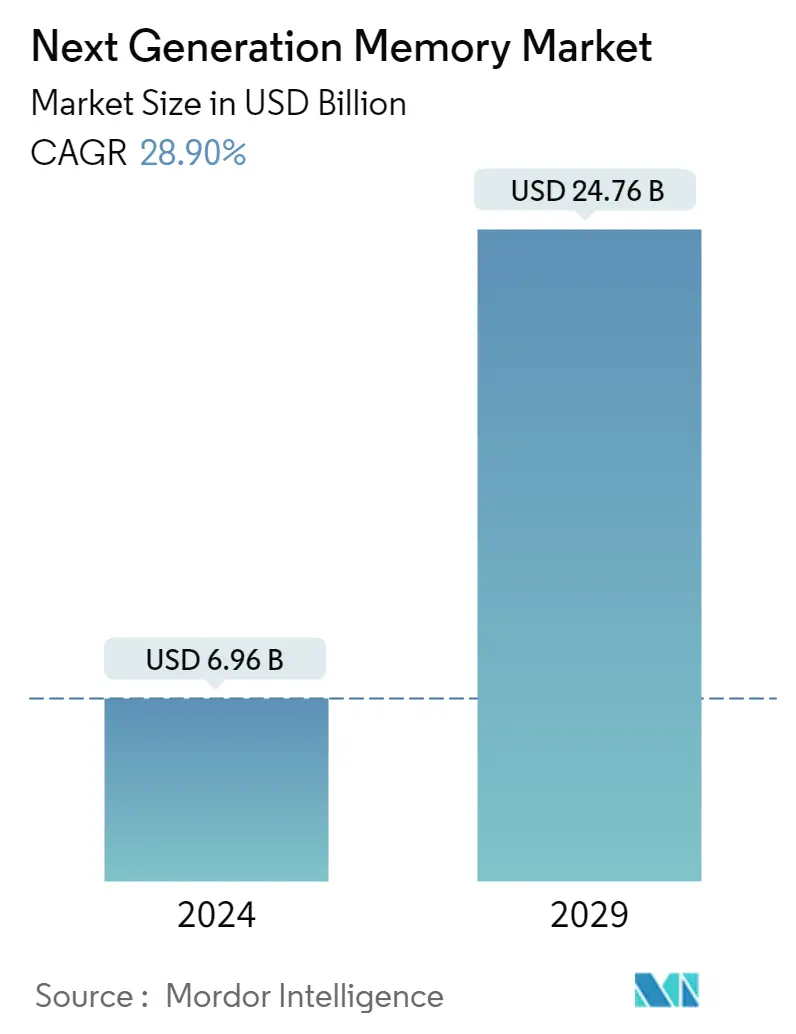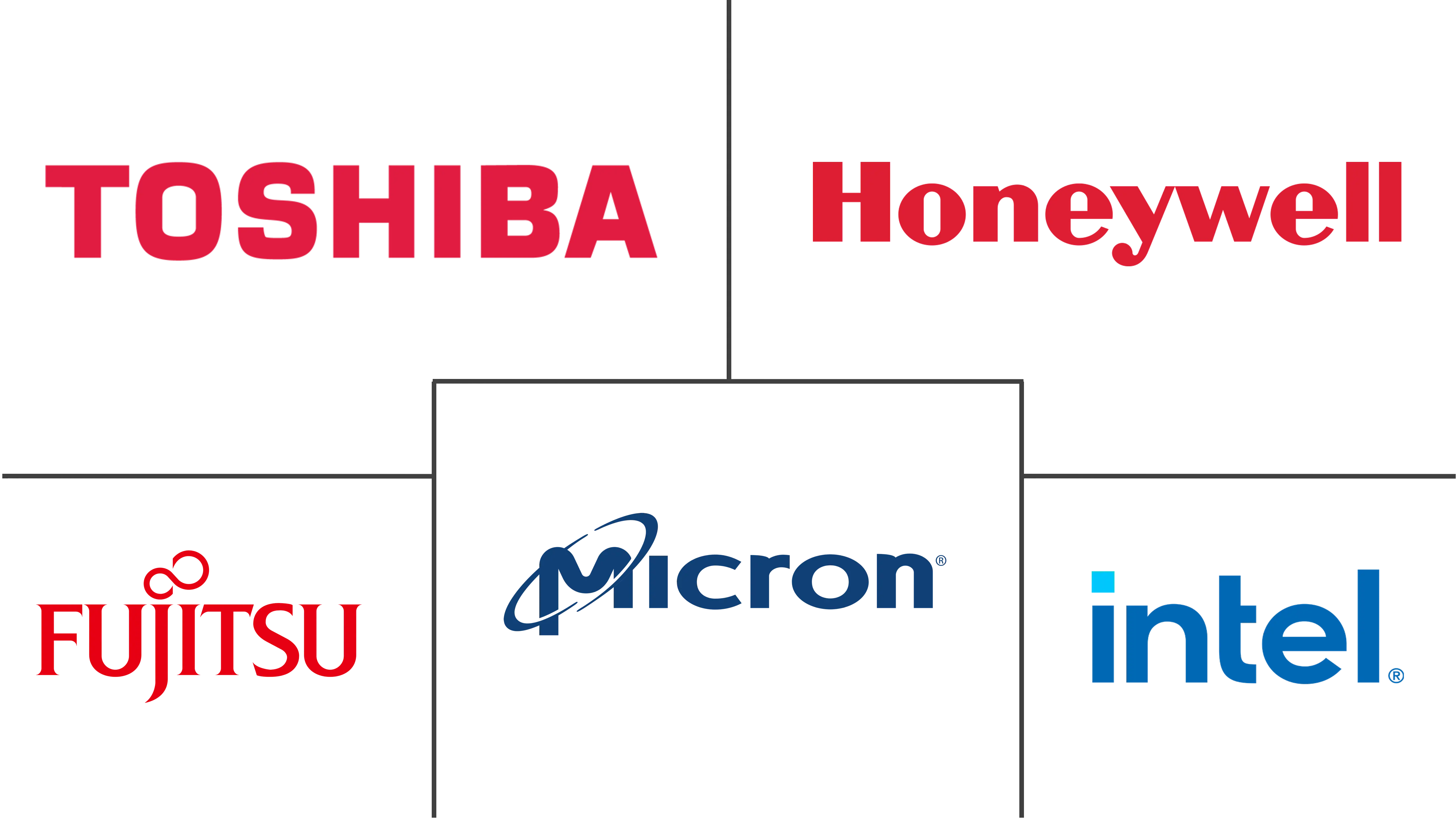Market Size of Next Generation Memory Industry

| Study Period | 2019 - 2029 |
| Market Size (2024) | USD 6.96 Billion |
| Market Size (2029) | USD 24.76 Billion |
| CAGR (2024 - 2029) | 28.90 % |
| Fastest Growing Market | Asia-Pacific |
| Largest Market | North America |
Major Players
*Disclaimer: Major Players sorted in no particular order |
Next Generation Memory Market Analysis
The Next Generation Memory Market size is estimated at USD 6.96 billion in 2024, and is expected to reach USD 24.76 billion by 2029, growing at a CAGR of 28.90% during the forecast period (2024-2029).
- Emerging technologies like artificial intelligence (AI), machine learning (ML), the Internet of Things (IoT), big data, etc., have a growing need for memory devices with high bandwidth, high scalability, and low power consumption. This, along with the growing need for enterprise storage, is one of the most important things driving the growth of the studied market.
- The rapid growth of data has increased the need for better memory and storage in the workplace. Older memory systems have been unable to keep up with the growing amount of data, the need for more bandwidth, and the speed of newer systems.
- With the demand for universal memory devices increasing, most of the new memory technologies aim to become universal memory devices to replace one of the members of the hierarchy with better technology. The high-end laptops use solid-state flash chips instead of huge mechanical hard disks and use the cloud for backup rather than tape drives. Recently, Intel announced Optane, which uses 3D XPoint technology and is close to universal memory. This is primarily a flash drive with non-volatile memory fast enough to function as RAM.
- The emerging non-volatile memory technologies, such as MRAM, STT-RAM, FRAM, phase-change memory (PCM), and ReRAM, combine the speed of SRAM, the density of DRAM, and the non-volatility of flash memory. Hence, these are possible additions to future memory technologies. Furthermore, implementing next-generation infotainment systems and ADAS would combine DRAM memory technologies with significantly higher performance and low power consumption capabilities.
- Furthermore, the increasing demand for enterprise storage applications is driving the market. The end-user industries, such as BFSI, invest heavily in IoT technologies and reap significant financial rewards. For instance, embedded MRAM is a promising technology for applications such as IoT. Also, other next-generation memories, such as 3D Xpoint, offer multiple times faster transfer speeds than the current SSDs.
- Considering the growing demand, vendors operating in the market continuously focus on launching new products to target emerging application areas. For instance, recently, Samsung Electronics announced the launch of their next generation of memory chips that promise to double the speed and offer the most extensive capacity yet. The company introduced these next-generation chips to target the growing demand across data centers and artificial intelligence applications.
- However, the lack of stability under extreme environmental conditions is restricting the market. Despite recent technological advancements, these memory devices are significantly impacted by harsh environmental conditions in terms of durability and reliability. For instance, the more thermal stress a memory device is exposed to, the greater the risk of damaging it, which challenges a market to grow.
- The global outbreak of COVID-19 had a notable impact on the growth of the studied market. However, in post pandemic scenario, the supply chain disruption improved, growth in investment in new IT infrastructures, growth in the adoption of digital technologies which positively impacted demand, such factors are expected to create growth opportunities for the studied market.
Next Generation Memory Industry Segmentation
Next-generation memory can be defined as a standard label applied to a significant upgrade of hardware or software. The next-generation memory market has grown over the last few years because of the increasing demand for faster, more efficient, and more cost-effective memory solutions. Big Data and artificial intelligence (AI) applications drive innovation across many industries, including machine learning.
The Next-generation memory market is segmented by technology [non-volatile (magneto-resistive random-access memory, ferroelectric RAM, resistive random-access memory, 3D Xpoint, nano RAM, and other non-volatile technologies) and volatile (hybrid memory cube, high-bandwidth memory)], by application (BFSI, consumer electronics, government, telecommunications, information technology, and other applications), and by geography (North america, Europe, Asia-pacific, Latin America, and Middle East & Africa). The market sizes and forecasts are provided in terms of value (USD) for all the above segments.
| By Technology | ||||||||
| ||||||||
|
| By Application | |
| BFSI | |
| Consumer Electronics | |
| Government | |
| Telecommunications | |
| Information Technology | |
| Other Applications |
| By Geography | |
| North America | |
| Europe | |
| Asia-Pacific | |
| Latin America | |
| Middle East & Africa |
Next Generation Memory Market Size Summary
The Next-Generation Memory Market is poised for significant expansion, driven by the increasing demand for high-performance memory solutions across various sectors. Emerging technologies such as artificial intelligence, machine learning, and the Internet of Things are fueling the need for memory devices that offer high bandwidth, scalability, and low power consumption. This demand is further amplified by the rapid growth of data, which has outpaced the capabilities of traditional memory systems. The market is witnessing a shift towards universal memory devices, with innovations like Intel's Optane and 3D XPoint technology aiming to replace older systems with more efficient alternatives. Non-volatile memory technologies, including MRAM, STT-RAM, and ReRAM, are gaining traction for their ability to combine the speed of SRAM, the density of DRAM, and the non-volatility of flash memory, making them suitable for future applications in enterprise storage and advanced infotainment systems.
The competitive landscape of the Next-Generation Memory Market is characterized by the presence of major players such as Intel Corporation, Toshiba Corporation, and Fujitsu Ltd., who are continuously innovating to maintain their market positions. The market's growth is supported by increasing investments in data centers, particularly in North America, where the adoption of cloud services and hybrid systems is on the rise. Government initiatives, like the US Data Center Optimization Initiative, are further bolstering the market by promoting the consolidation and enhancement of data center infrastructure. Despite challenges such as the lack of stability under extreme environmental conditions, the market is expected to benefit from the post-pandemic recovery, with improved supply chains and a surge in digital technology adoption. The introduction of advanced memory solutions, such as Samsung's GDDR7 DRAM and Micron's investment in Japan, underscores the ongoing technological advancements and strategic moves aimed at capturing emerging market opportunities.
Next Generation Memory Market Size - Table of Contents
-
1. MARKET INSIGHTS
-
1.1 Market Overview
-
1.2 Industry Value Chain Analysis
-
1.3 Industry Attractiveness - Porter's Five Forces Analysis
-
1.3.1 Threat of New Entrants
-
1.3.2 Bargaining Power of Buyers
-
1.3.3 Bargaining Power of Suppliers
-
1.3.4 Threat of Substitute Products
-
1.3.5 Intensity of Competitive Rivalry
-
-
1.4 Impact of COVID-19 on the Market
-
-
2. MARKET SEGMENTATION
-
2.1 By Technology
-
2.1.1 Non-volatile
-
2.1.1.1 Magneto-Resistive Random-Access Memory (MRAM)
-
2.1.1.2 Ferroelectric RAM (FRAM)
-
2.1.1.3 Resistive Random-Access Memory (ReRAM)
-
2.1.1.4 3D Xpoint
-
2.1.1.5 Nano RAM
-
2.1.1.6 Other Non-volatile Technologies (Phase change RAM, STT-RAM, and SRAM)
-
-
2.1.2 Volatile
-
2.1.2.1 Hybrid Memory Cube (HMC)
-
2.1.2.2 High-bandwidth Memory (HBM)
-
-
-
2.2 By Application
-
2.2.1 BFSI
-
2.2.2 Consumer Electronics
-
2.2.3 Government
-
2.2.4 Telecommunications
-
2.2.5 Information Technology
-
2.2.6 Other Applications
-
-
2.3 By Geography
-
2.3.1 North America
-
2.3.2 Europe
-
2.3.3 Asia-Pacific
-
2.3.4 Latin America
-
2.3.5 Middle East & Africa
-
-
Next Generation Memory Market Size FAQs
How big is the Next Generation Memory Market?
The Next Generation Memory Market size is expected to reach USD 6.96 billion in 2024 and grow at a CAGR of 28.90% to reach USD 24.76 billion by 2029.
What is the current Next Generation Memory Market size?
In 2024, the Next Generation Memory Market size is expected to reach USD 6.96 billion.

